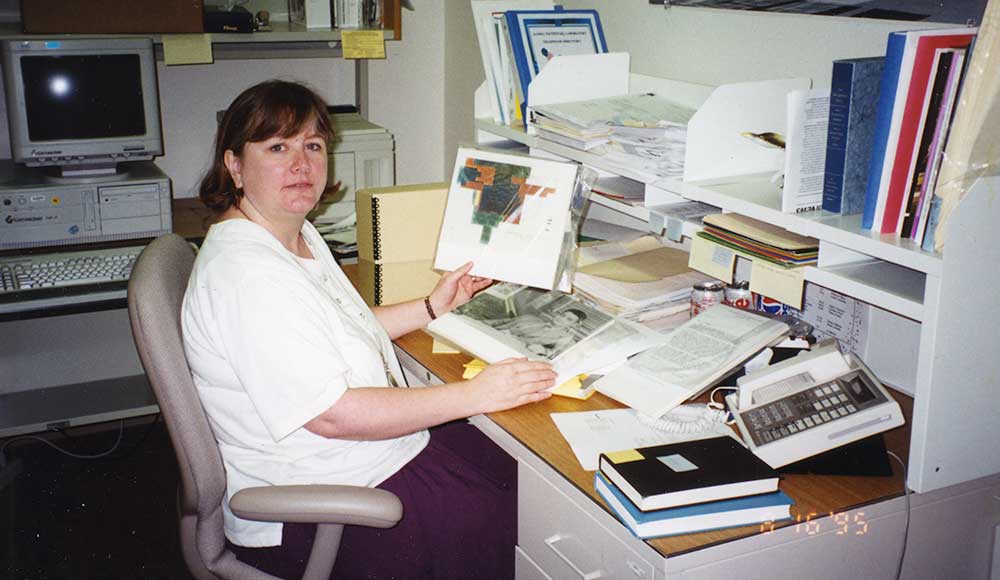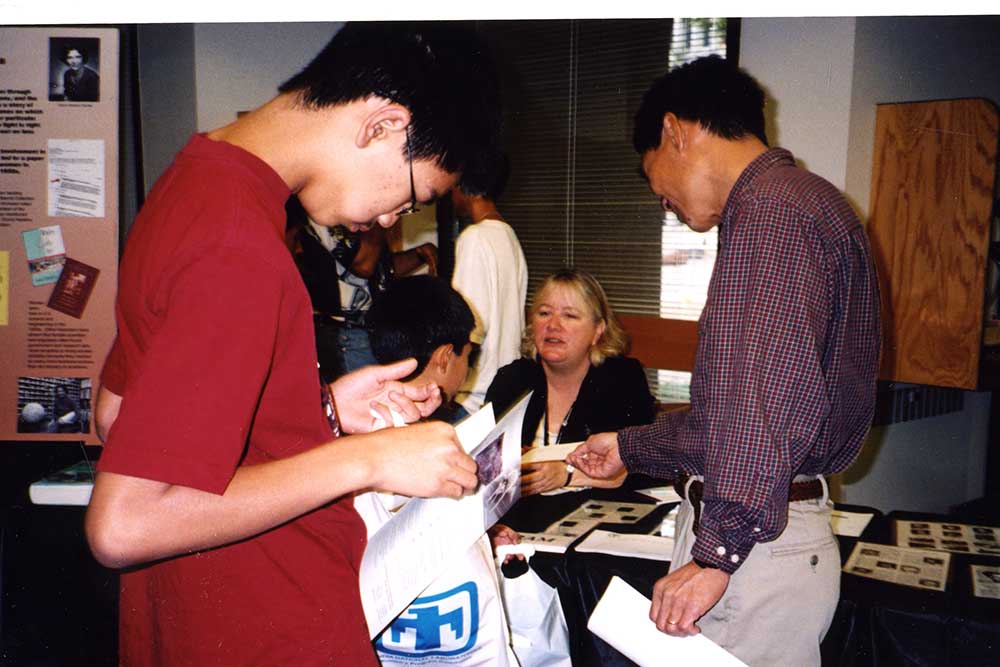 2024 — Rebecca speaks to a crowd gathered to celebrate Sandia’s 75th anniversary. (Photo by Craig Fritz)
2024 — Rebecca speaks to a crowd gathered to celebrate Sandia’s 75th anniversary. (Photo by Craig Fritz) 1995 — Rebecca Ullrich at her desk in 1995, the year after she joined Sandia as research historian. (Photo from the Sandia archives)
1995 — Rebecca Ullrich at her desk in 1995, the year after she joined Sandia as research historian. (Photo from the Sandia archives)Sandia historian Rebecca Ullrich has seen a lot in her nearly three decades at the Labs. But as she explains, that’s what she’s here for: “to observe.”
“It’s been a lot like watching a river go by in front of me,” she said. “Observing how the Labs has changed, how we’ve dealt with change and uncertainty both internally and in the world around us.”
When Rebecca started in 1994, the Cold War had ended, the United States had declared a moratorium on underground nuclear testing and the country was discussing a peace dividend.
“The Labs was entering a period of uncertainty,” she said. “If we’re no longer building any new nuclear weapons, and there’s just the maintenance of the stockpile — which is no minor thing — some were asking whether there was still a need for the Labs.”
Sandia, like many defense-related organizations at the time, was trying to figure out its position in a post-Cold War environment.
 2001 — Rebecca shows off the Record of Life Cycle exhibit as part of an Information Management Week event in 2001. (Photo from the Sandia archives)
2001 — Rebecca shows off the Record of Life Cycle exhibit as part of an Information Management Week event in 2001. (Photo from the Sandia archives)“There was a lot of soul searching and philosophical discussion going on,” she said. “Then the Stockpile Stewardship Program was introduced, prompting a shift in focus and a reevaluation of staffing needs.”
The Labs was downsizing, and as a result there were voluntary separation packages offered in 1996 and 1997, with some involuntary separations a few years later.
“It was a precarious time to be an employee,” Rebecca said. “But as the historian, my job was to watch how Sandia handled these changes, observing how leadership — first Al Narath and then Paul Robinson — coped with what was going on while also trying to preserve morale.”
In the following years, Sandia began to find its footing, expanding its work in counterterrorism, energy, cybersecurity and counterintelligence, slowly transforming into a multimission laboratory.
Wen Ho Lee fallout
Then, in 1999, Los Alamos National Laboratory scientist Wen Ho Lee was arrested and charged with mishandling classified nuclear weapon design information. The high-profile investigation and legal proceedings that followed raised significant alarms about security practices within the U.S. nuclear weapons complex.
Secretary of Energy Bill Richardson initiated a review of security measures across DOE and its labs, including Sandia, in an effort to find weaknesses and enhance protections for sensitive information. The situation prompted a push for broader reforms to improve oversight and management of classified information to help improve national security and prevent similar incidents from happening again.
Answering the call
By January 2001, Rebecca said things were on the upswing at Sandia.
“In the State of the Labs address, Paul and deputy director Joan Woodard said the budget had turned and expressed optimism,” she said. “It was all positive. Programs were moving forward. We were going to see some life extensions come into play. Stockpile surveillance was going great. Computing was going great. Sandia was in a really good place.
“And then 9/11 happened.”
Rebecca recalls driving to work when she heard about the first plane crashing into the World Trade Center, and then halfway in, she remembers the radio broadcaster announcing that a second plane had hit the south tower.
“I pulled over, called my husband, and told him to turn on the TV — something big was happening,” she said. “When I got to work, people were huddled around the televisions in the break rooms. No one knew what was happening. Then we saw the towers collapse, and everyone was just in shock. It was really scary.
“Eventually, they decided to send us home, and we received a voice message on our desk phones. I remember hearing Paul’s voice telling us what had happened, that we didn’t know what it meant, but they were sending us home. Then he reminded us that our service was still needed. Maybe it was the timbre of his voice, but I felt so reassured in that moment. If Paul says it’s going to be OK, if he says we’re going to be fine, then we’re going to be OK.”
The next day, while other flights were grounded, a flight carrying around 50 Sandians departed from Albuquerque en route to Washington, D.C., with an Air Force escort.
The group would provide critical technical expertise and support to help assess the damage and investigate the attacks in the days that followed.
“I think Sandia being called upon in that moment was a statement about how important the Labs’ work is,” Rebecca said. “How vital Sandia is to national security.”
The stories
When asked what she loves about history, Rebecca points to the stories and narratives.
 2003 — Rebecca greets children and families attending Sandia’s Annual Take Your Son to Work Week. (Photo from the Sandia archives)
2003 — Rebecca greets children and families attending Sandia’s Annual Take Your Son to Work Week. (Photo from the Sandia archives)“History is full of complicated stories about how we got from here to there, because we could have ended up anywhere. But there’s this path — decisions that were made, events that happened — that brought us to where we are,” she said. “Sometimes people talk about history as if it’s inevitable because we know the punchline; we know how it ends. But I love the stories that get us there, the ones we’re still part of. We don’t know the endings.”
And Sandia’s story, according to Rebecca, is still very much a river in motion, meandering through challenges but always moving forward.
“Sandia has been through a lot — the Labs, the workforce — but it has always gotten through, and there’s no reason for that to change as long as it is meeting the needs of the nation,” she said. “In times of uncertainty, when things are scary and out of our control, I believe the best we can do is fall back on what we do well, and at the Labs, that is to solve problems and produce. So, let’s keep doing what we’re good at.”
Looking ahead
 2025 — Rebecca speaks to students from Rice University during a tour
2025 — Rebecca speaks to students from Rice University during a tourof the National Museum of Nuclear Science & History on Oct. 14. (Photo by Craig Fritz)
On Nov. 3, after 28 years of service, Rebecca archived her work, turned in her badge and hung up her metaphorical historian hat.
“Sandia really embraces its history, and so does the workforce,” she said. “They’re interested in the past of this place, what they’ve inherited and therefore what they can do. I hope I’ve been able to play a small part in that — keeping history alive and in front of them so that they can absorb and appreciate it and make it part of their experience here.”
Rebecca’s reflections on what Sandians have been through, how they’ve risen to the occasion and how they’ve persevered offer comfort. Maybe it’s the timbre of her voice, but when Rebecca says it’s going to be OK, then we’re going to be OK.
.png)



